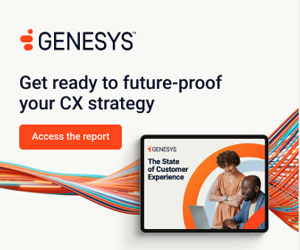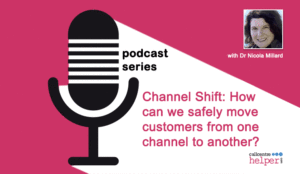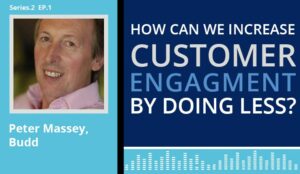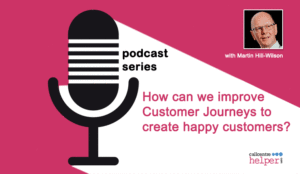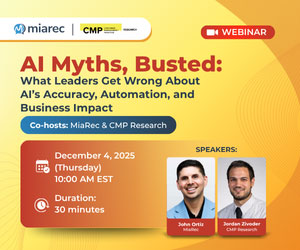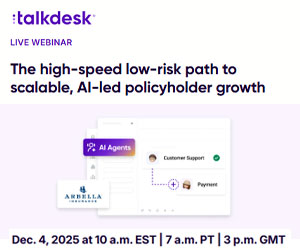The Contact Centre Podcast: Episode Six

In this episode, Dr Nicola Millard of BT discusses the latest trends in customer behaviour and how they may influence your channel shift strategy.
As part of our discussion, we also talk about how you can improve your digital customer service strategy, the growth of live chat and the future of the contact centre.
To listen to the podcast directly from this web page, just hit the play button below:
The Contact Centre Podcast – Episode 6:
Channel Shift: How Can We Safely Move Customers From One Channel To Another?
This podcast was made possible by our sponsor, Genesys.
Podcast Time Stamps
- 1:59 – Customer Channel Preferences
- 4:41 – The Wrong Motives for Channel Shift
- 7:26 – Channel Shift Mistakes
- 11:43 – Creating a Channel Shift Strategy
- 14:12 – The Popularity of Live Chat
- 18:36 – The Rules of Passing Contacts to Chatbots
- 23:29 – Becoming More Proactive
- 27:15 – The Contact Centre Agents of the Future
Here is a Transcript to the Podcast
Charlie Mitchell: We hear a lot about the growth of channels like chat, messaging apps and now even video. With that being said, is the phone still relevant and should it still be a key part of your digital strategy?
Dr Nicola Millard: Oddly enough, the research that we’ve been doing is showing that the phone is still, usually, either the number-one or the number-two choice for customers that have a really meaty problem. So, particularly we call them customers in crisis. Their instinct is often to lift the phone up. Mainly because it’s… Customers tend to go for the channel they think is going to be easy and I think the phone… They don’t think it’s going to be necessarily an easy experience but I think it’s one of those ones that takes on complexity and emotiveness very well. So, we’re seeing that shift, I think, into the phone channel. It’s not going away. It’s not necessarily first preference, but if it becomes a complex or emotive problem, the phone actually takes that on pretty well. So, as long as you’ve got an agent that can actually cope. I keep saying there’s no point in just having a lovely person that can’t help. The guys that typically are on the phone channel are now taking some very, very hard stuff.
So, it’s the complex stuff that requires a conversation or it’s the emotive stuff that requires the agent to calm the customer down. So yeah, I don’t think the phone is going away. It’s certainly going down in preference. I think that’s largely because we’ve got a whole load of other channels, particularly self-service. I think customers rather like that because it puts them in control. I think by the time we actually get to that point at which we’re going to have to lift the phone is because we have quite a big problem. Sometimes it’s also, of course, we’ve been having problems with the self-service channel. Hence we also have been, from our research, getting some feedback from customers that they absolutely hate when you get the first message when you pick up the phone and dial the number is “Did you know you could do this online?”
Because typically, I tried that. That’s why I am ringing you. So, it can be symptomatic of the fact that the digital channels are causing issues that’s causing the phone call, and then we’re also getting feedback that because of that complexity, the agents are having to put the customers on hold or they have to consult either a database or some of their colleagues to actually figure out the answer to the problem. And I think that’s actually not necessarily a bad thing. It’s basically the agents are having to work pretty hard. They’re having to engage their brains because it is the complex stuff and I think the challenge is firstly, you’ve got to upskill your agents to take on that complexity, but also provide them with the knowledge, resources and the network of experts, if you like, to try and solve these very complex and emotive problems on behalf of the customer.
So, a long-winded answer, but I don’t think the phone is going away. I think it is a very good channel for that complex stuff.
Charlie: Yeah. I think it is still very relevant for those emotive issues that you alluded to there. So, why do you think contact centres want to move customers away from the channel so much?
Nicola: It’s all to do with cost. But it’s quite interesting that… Typically I work with a lot of retail banking customers. So, we’re typically on retail banking, seeing things like calls are going down, so we’re not getting as many contacts coming through. But call handling times are going up by as much as 40%. So, if you’re just looking at it from a cost basis, yes the phone could be an expensive channel, but actually it’s adding value to the customer.
A lot of this is driven by cost and I keep saying when we look at channels like email, for example, email can get very expensive as a channel. I always consider email to be a little bit like a slow tennis match. Now firstly, customers like email because it does put them in control. They [inaudible 00:05:29] it’s on their time, they don’t have to stick around for the answer. So, there are a lot of benefits from a customer perspective around email. But, on average, a lot of email conversations, it’s two or three email interactions. So, if you look at that as a total, that becomes quite expensive. Which is why a lot of the clients I talk to are quite keen to move people away from email and onto chat, which because of the way… Well, again, it depends how you manage it, but chat can be a far cheaper channel.
It’s a synchronous channel so hopefully you can figure out the problem and get it solved all in one go. But it does require the customer to be there. So, there are always swings and roundabouts about channels, but it is ultimately a lot to do with cost. The trouble is that it’s not necessarily as simple as an equation of “I’ll take them off the phone and put them into chats because that’s cheaper.” One of the things that we found, certainly with channel choices, is the more channels you give customers, the more channels they will use, and the trouble then is around things like channel duplication that the customer might send an email and be on a chat session and be sitting in the phone queue all about the same problem. And then you get double handling or inconsistent replies, depending on who is actually manning which channel, because maybe the social media channel isn’t run by the same people as the contact centre. So, they might give a completely different answer, which will then confuse the customer, which will probably generate more contact.
So I think it’s not as easy as X channel costs this much, Y channel costs this much, let’s shift people. I think it’s much more around, “Well let’s try and understand the customer behaviours as to why they’re using that channel” and then actually to realize that sometimes they will use more than one channel at the same time to answer the same question. And that’s got a cost associated with it as well. So the costing tends to be… Maybe you need to take a slightly more umbrella view of how channels are being used by customers rather than siloing the channels.
Charlie: Yeah, I think that’s one common mistake, as you say, just trying to shift customers to the cheapest channel. Are there any other common mistakes that you found organizations making when they’ve become too anxious to switch customers from one channel to another?
Nicola: Well, as I said, I think it often is that naive assumption that maybe you can switch one channel off and people will migrate to another. I always say from a behavioural perspective, which is where I typically come from, customers typically are in the mindset… They don’t think channels, they have a goal. We talk about omnichannel all the time and we did actually sit some customers down and interview them and we asked them “Are you omnichannel?” and they had no clue what we were talking about because that’s the word we use. It’s not the word that customers use.
Nicola: So, it rapidly became apparent from those interviews and a lot of our subsequent research that customers have a goal in mind and then typically they’ll go to the channel that they think is going to get them to their goal as easily as possible, because obviously we want an easy life as well. So easy tends to be an absolute primary driver for customers. And also that control piece I mentioned earlier. Customers do quite like to be in control, which is why if we can give them self-service tools that work, appropriately, for the appropriate goal, I think they quite like solving problems themselves. They don’t have to contact us as organizations. So yeah, I think we’ve got to think about that ease of use and that goal and then try and sign post the customer better, in terms of making sure they get to the right channel to fulfil that goal. And typically, again from the research that we’ve done, customers tend to fall into three categories when they’re doing goals, and we call them three intention states, which are typically positive, negative or neutral.
So, we call the positively motivated customers visionaries. Visionaries tend to have… They want to do what they’re doing. So they’re going on holiday, they’re getting married, they’re planning the perfect picnic. So they do their research. We call them shopper swots. They’ll really do their research and they’re willing to invest time, energy and effort to do that. Now they sometimes need a bit of a prod because choice can be a double-edged sword. It’s great to have choice, but too much choice means that we’re not sure what’s right for us. So they might just need a bit of advice. Sometimes you could put a bot in, sometimes they need human contact with an expert. But as long as you don’t confuse them, visionaries are not necessarily problematic. They will use a lot of channels, though. So again, that assumption that we’ll move them onto one channel and they’ll stay in that one channel doesn’t necessarily work with visionaries.
The problem, of course, also comes with visionaries that if they then become angry, frustrated, or they can’t get to their goal, they flip into a very different mode, and we call these customers in crisis, and customers in crisis typically use channels in a very different way. So, I mentioned earlier, the phone tends to be a quite primary channel when we get into that crisis point. We think we’re going to have to lift the phone up and we need this problem sorted out. So visionaries use lots of channels. Customers in crisis don’t. They typically do want to lift the phone up or they want human contact. They’ll go for chat as well. If all of that fails, they might go onto social media for a moan and a whinge. But these are quite difficult customers to sort out. They’re quite difficult customers. At the extreme of anger and frustration our short-term memory capacity gets compromised. So, we don’t take in a lot of detailed FAQs and we don’t take on complexity terribly well. So, we need to make it very simple for customers in crisis, and sadly, that is the bulk of customers that come in through the phone to the contact centre.
And then we’ve got the midpoint, the utilitarians, who are simply doing transactional emotion-neutral stuff and that’s where things like self-service tends to come in very well because we don’t need wow. We don’t need a conversation. We just need the tools that enable us to do those transactional things like checking a balance or buying carrots or… I don’t need a particularly elaborate experience at that point, I just want to do it fast and I want to do it easily and I want to do it quick. All of those things become very important to utilitarians.
So, instantly we start to see that planning map. The way that we signpost customers may depend on what their goal is and what that intention state beneath the goal is, and I think that’s the key to doing an omnichannel strategy. As much as I hate the word omnichannel, I’m going to use it. But how do we start to introduce the right channels for customers and how do we signpost customers to those right channels? Also bearing in mind they might flip between the intention states as they go along, depending on how that experience is going.
Charlie: So, do you think we should, as we would for our customer journey mapping, the mapping the decisions that a customer makes and then aligning a strategy to that?
Nicola: Completely, because I always say that we tend to be obsessed with channels; customers are not. And I think we just basically have to bear in mind what customers want from us as organizations. Try and figure out where their goal state is and absolutely try and make that journey. Almost handhold them, signpost them, help them to achieve their goal using the tools that are appropriate. And sometimes that is a phone number. I think some organizations, in a desperate race to try and cut their phone calls, are hiding their phone number and sometimes a customer in crisis is just hunting for that phone number and if it’s really, really difficult, you’ll then get channel leakage, and they’ll go off onto all sorts of other channels until they find the phone number. And again, that can cause cost. So, if you’re looking at managing costs, you need to just look at those behaviours and say, “Actually this could be generating more costs simply by, if I hide the phone number, if I put the phone number up there, yes they will call us but actually that might be the most effective way of doing it”.
Charlie: I think that’s an interesting term that I haven’t really heard before. Channel leakage. Is this a metric that’s coming in now that can be measured to assess the effectiveness of our omnichannel strategy?
Nicola: Channel leakage? Yeah, absolutely. I think we need to recognize that sort of behavioural stuff that’s going on with customers and say, “Well, how are they using the channels that they’re using?”. And that is difficult to track because we can’t always see. And as I said, we tend to silo those channels within organizations as well. So, we don’t necessarily have a view across all channels. The classic one being the social channel is often very much distinct to other channels and isn’t necessarily measured as part of a contact centre, which is why that contact centre strategy side needs to encompass all channels really.
It’s not just about the phone any more. We need to be cognizant of how customers are using all of those channels, and it is sometimes very, very difficult to track it. That’s why we do an awful lot of interviews and research to try and figure out, well, what are the behaviours with customers? What are they trying to do and how are they shifting channels? And why? Why do they feel the need, sometimes, to start on one channel? Typically, they will start digital and then they’ll shift around depending on what they want to do and whether they’ve managed to do it on the digital channels. So yeah, I think we need to take a slightly less channel-centric view of customer experience journeys and take a much more customer-centric view.
Charlie: And I think one of the really in channels that I’m certainly seeing at the moment that customers really like to use is live chat. Would you go along with this and why do you think it might be so popular for customers?
Nicola: I mean, our research… We’re about to do our new piece of research on customers, but our previous research was showing in two years that we’d had a 20% growth in preference with customers on chat and it was the… Chat is where it’s at. It’s the rising channel in terms of customer preference and I think that, again, trying to delve into why that is. It’s a digital-first channel. So, that’s the first thing. It’s regarded as an easy channel by customers. So, again, they found a chat button and they can push it.
Actually, economically, it tends to have a… From an organizational perspective, they quite like the economics of chat because you can have – obviously, it depends how you manage it and how complex the chats are – but you can have concurrency and agents working on multiple chat sessions. But the more complex those chats get, probably, the less simultaneous chats they can cope with. So, I always say two to three chats is probably a maximum.
And then actually, we did a lot of agent interviews at one point around chat. And agents like it as well because they don’t have to make small talk. You’d have to put customers on hold. So, all of that I think… You’ve got a three-way pull. Customers like it, it’s easy. It’s a digital-first channel. Agents like it and the economics tend to stack up. I’m not sure that in the newer iteration of the research we’re going to see quite as much growth, but I think it is one of the few channels, in fact, that is on upward trajectory in terms of take-up with customers.
Charlie: It certainly is one that I like, to myself use, and I think I’ve been to a contact centre recently that used it well in terms of agents handle two and then they can request the third one to empower them to take on extra responsibility if they think they have the time and the resources to cope with it. And I think it’s obviously dependent on which contact centre you’re in as well, because if you’re a charity and it’s a very emotional live chat, maybe just the one-to-one. So, maybe it wouldn’t be the cheapest option in that regard.
Nicola: Yeah, and I think as you put more automation in as well. So, obviously chat and chatbots tend to go together. And actually the inevitable consequence of that is what we’ve seen in the phone channel. So, you get the complex and emotive stuff that the automation doesn’t handle terribly well. So, inevitably the job for the agents tends to get harder once you put more automation upfront, and again, the economic case then starts to get interesting because you have to invest in your agents, you have to upscale your agents. You might also have to pay your agents a little bit more.
Charlie: Yeah. I think that brings on to the topic of how the advisor role will change. It’s just something I do want to get into. But just finishing on live chat, is there any ways in which you think contact centres can better promote live chat and self-service options for those utilitarian customers that you were talking about earlier?
Nicola: I think there’s a fine balance. Again, another thing that’s come up in interviews that customers tend to hate is the very invasive chat service. That as soon as you get onto the website, there’s a big box that comes up and going, “Do you want to chat with us?”
And I always say, if you treat that as a human… It’s kind of the equivalent of walking into the retail store and the person right at the door saying, “Can I help you?” It’s almost too much in your face. So, I think it is around not hiding the option, actually promoting the option, making sure it’s very visible to the customer, but not making it too much in your face because actually customers might not welcome that as much as you might think. But yeah, I think if you can make the chat button obvious without being intrusive, I think that makes it easy for customers.
Also, I mean, contextualize it as well. We, I know, originally put our chat button right up front in BT.com and we got people just randomly pushing it and asking weird questions. But if you can then position your chat buttons on certain products that maybe are more complex, that are likely to get questions, you can then also skills-based route that to the best advisor. And also the dynamic chat as well. So, don’t put a chat button up if you’ve got no agents to actually answer it. So again, managing that customer experience around chats. But I think that the positive news on chat is customers typically do like it. So as I said, it’s one of the few growth channels that we’re seeing.
Charlie: That idea of having live chat buttons more obvious on products which require specialist advisors and routing them through is a very interesting use of technology, actually. Another technology that you introduced earlier was chatbots on the channel. Which companies have you seen using chatbots well? And do you think they can be a good channel to shift to?
Nicola: Yeah, chatbots are an interesting one. I’ve got about 13 or 14 different projects around chatbots now in all sorts of industries as well. Mainly financial services. I think the problem is the hype at the moment, and then there are two sides of the hype. So firstly, the research that we did was showing that something like, I think, 73% of customers were saying they thought that chatbots could potentially improve the customer experience. And that was two years ago, so that was peak hype cycle. I think the experience that I’ve had with chatbots, and we’re going to see on the new research, hopefully if that’s changed, but the experience I’ve had with practical chatbots has been very mixed and I would say biased towards the bad rather than the good. So, I would say that there are some horrendous experiences I’ve had with chatbots that are just very limited or simply couldn’t answer the question, couldn’t understand, got up with the wrong answer, or simply gone, “I’m sorry, I don’t understand you. You’re going to have to start again with a live agent”. Which is not a great customer experience.
Nicola: So, from a customer perspective, I think it’s kind of 80:20 in terms of 20% are really good. 80% are really not very well deployed at all. So, there are some good ones out there. I’ve always said that I like the ones that typically are narrow and deep because they tend to work very well. These things work by data. So, if you’ve got a narrow and deep data set, it tends to be much more effective than a wide dispersed data set that basically can’t do anything much in any great depth.
So, the supermarket did one called Margo, the wine bot, which was just looking at food and wine combinations because that’s a really sticky topic. You need to know wine very well to know what wine goes with which food, and I don’t and I’m terrible at it. So, simply having a bot that will help you, if you’re having fish and chips for supper, a bot that says, “Champagne would be perfect with that.” Obviously that’s going to increase the cost of my fishy Friday a bit. But apparently that is true. Champagne goes very well with fish and chips. That helps me navigate the minefield of a quite complex topic where there is a lot of choice.
I think the bots that don’t work so well tend to be… “ask me anything” is very difficult to do. Also, where is it deployed? So, we did some stuff around complaints. Probably not the best place to put a bot because complaints can be very long. That’s the first problem, and human language is vastly redundant. So, you need to strip out all of the irrelevant bits and then identify the important bits to the bots in order for the bot to understand what that complaint’s about rather than the blow-by-blow account of what’s happened to the customer. So, that’s the first challenge.
The second challenge, I’ve said is a very big one, particularly in the UK and Ireland, where you get people being sarcastic when they complain. And again, algorithms don’t get sarcasm. You need to teach an algorithm about sarcasm, and sarcasm can be quite subtle. My favourite example is when we picked up that an algorithm had said was positive which was, “It was so good to see your maintenance department hadn’t spoiled things by making unnecessary repairs.” Now we know that’s sarcastic, I don’t even know how I would teach an algorithm that that’s sarcastic. And there’s another one that we picked up, which was to a particular train operating company saying “Thank you for my free sauna this morning.” And again, the bot wouldn’t know that that’s a negative experience because it’s never been on a train. It’s never been in a sauna. Stick the two together, it is quite unpleasant. It wouldn’t know that. I’d need to teach it.
So, you have to tag a lot of this stuff and that’s a lot of work. That’s a lot of cost. And then that bad experience of having a conversation with the bot and then the bot stopping and you’re having to repeat the entire experience through another channel with a human agent. A lot of the innovation stuff that we’ve been doing has – and this is hard as well, by the way – is to try and take that context and figure out how do I skills-based route it to the right agent with the right skills? And also, easier, is to take that entire conversation across to the agent desktop so they can actually read through it and figure out what the customer’s been saying. So the customer doesn’t have to repeat themselves.
So, I think chatbots are very trendy at the moment. I think the question I always ask is why do you want one? And the answer should be, “It’s to free my agents’ time up to deal with the more complex stuff”. But then you also have to think about appropriate deployment. Customers in crisis probably won’t deal with chatbots terribly well. So again, is it the right place to put a bot?
Charlie: Yeah. I think there are still lots of misconceptions about chatbots. As you say, like detecting sarcasm and that there’s… They’re almost a plug-and-play device when they take many months of training, and that’s probably why we’re seeing a shift towards agent assist so the advisor can help train them. Which is another interesting thing. But if chatbots are to continue to improve and self-service is improving as well, these transactional contacts will surely decrease and decrease maybe with… Do you think businesses will turn to a more proactive strategy to decrease these contact volumes?
Nicola: Absolutely, and I think proactive is one of those big ones that is a future trend that is starting to get momentum, and I always say a lot of these things do not work by magic. A lot of this works by data, and when you’re looking at proactive, actually that’s the second step. The first step is around personalization. So you need to learn about the customer, and that is all about the customer teaching you about them. I call this a me economy. And this is interesting because customers are willing to do that if they get something back. So, I’ve said all along that Amazon and Netflix have been doing this for many, many years. They learn absolutely everything about me. I teach them and I’m willing for them to have my data because they then personalize the experience. They maybe curate the choices that I’m likely to make to the ones that are appropriate to me.
So, there’s a benefit to doing that. But until you understand the customer, you probably can’t be proactive with them. So, once you’ve got personalization, you can then start to say, “Well, how do I tell customers things that they need to know through the channel that they need to know it, at the time they need to know?” And again, working in the AI space, you can use algorithms to do an awful lot around that. So, trying to figure out who the customer is, what they’re likely to know, what channels they tend to use. And again, when are they going to be using them? So what time should we send these proactive messages out? If you get that right, there’s a benefit to the customer. Again, the me economy, I will give you my data because you’re telling me stuff I need to know before I need to tell you.
There is a problem there if it’s irrelevant stuff and it’s irritating. I always… Again, let’s use a human analogy. If I’m walking down the street and someone’s continuously tapping me on the shoulder saying, “Did you know?” I’m soon going to punch them. So again, that’s the point at which I go, “No, you’re not having my data any more because you’re just annoying.” So there’s a very fine line there.
So, we’ve got personalized then proactive and then we can start to kick the algorithms in and start to get predictive. So, using that data to start to anticipate what the customer’s next move is, what they’re likely to want before they even know. And again, this is all about data. Obviously, supermarkets, especially, have got very good at doing this. To the extent to which one or two of them have got so good that I was talking to one of the big supermarkets, probably last year actually. He was saying that they could tell if you’re about to get divorced from your data.
Now, there’s a difference between knowing that and doing something about it, and I think that’s where that human-in-the-loop thing comes in because it’s not necessarily appropriate to send somebody a message saying, “I’m sorry to hear you’re getting divorced” because you might not know. So, maybe subtle things like offers for wine might be appropriate. But it’s really just looking at… you probably need a human in the loop at that point to try and say, “Well, if we’re going to become creepy…”, which again, if you’re looking at human analogies, that’s just the stranger that seems to know everything about you because they’ve been watching you. I’m probably going to say “No, you’re not having my data any more”. And under GDPR, I can, at any point, withdraw my consent.
So, I think this is a really interesting one and I think as we get into that realm of smart buildings, smart homes, Internet of Things where there’s a lot more data potentially flowing about customers, we also as corporates need to think about, “Well, what’s the benefit for the customer, not just the corporate, for the customer of sharing that information and what can we add in terms of the customer experience in terms of personalizing it, becoming proactive and then if appropriate, becoming predictive?”
Charlie: I think that’s very interesting as well. The part, especially, of you saying how all this needs a human in the loop, and that makes me think back to a little bit what we talked about earlier and how the contact centre advisor role is changing. How do you think maybe the advisor role will change in the next 10 years?
Nicola: Well, we did a paper last year called bot-man versus super-agent, mainly to dispel the myth that the robots were going to rise and replace all of our human agents. And I think contact centres are interesting in that we’ve already, even before we’ve deployed AI, we’ve put a lot of automation up, whether it’s IVR or chatbots or self-service. That does not necessarily eliminate the role of the human advisor. It changes it, and as part of the bot-man versus super-agent paper, what we did was to put together some personas that we thought might represent the role of the future agents.
So, we created Sally. Who is our Swiss army knife, I call her. So, this is the agent that picks up where the automation has failed, and it’s the human triage, if you like. So, probably the closest to our current advisor base in that that’s what they’ve been doing a lot anyway.
So, it is really around trying to figure out what the customer problem is and finding the best route to actually solve that problem. So Sally, as I said, she’ll also be teaching the bots and teaching the automation to get more accurate. But she’s probably closest to the current agent skillset we have.
We then have… Over and above that we’ve got Paula the problem solver. I described Paula’s role as sticking the fork into the spaghetti of backend process, and it’s typically where the computer has said no because a lot of automation is rules-based and, as we know, sometimes customers just fall between the gaps within process. So, Paula needs to take that up, figure out what’s going wrong and then manage the process on behalf of the customer so that it gets back on track. That often requires them to integrate in with supply chain, integrate in with the rest of the business, which is why we’re also seeing things like unified comms become much more prevalent in the contact centre because it’s a complex job. The contact centre is merely liaising with the rest of the business and the rest of the supply chain on behalf of the customer. So, they need to be able to contact and figure out what’s going on and what’s going wrong in order to solve the process. So, Paula’s definitely… Going to need a lot of Paulas.
Natalie’s a negotiator. Now negotiations are a very interesting one. Typically, we would look at the high-end escalations teams as the most close analogy, I guess, to current advisor roles. But negotiation’s rules-based. So, you can also make a certain amount of that. But it’s also very heavily social and emotional. So, it is about give and take and that’s a very human skill and that’s also quite a difficult skill to acquire. So, I think we’re probably going to need quite a lot of Natalies who are negotiating with the customers to try and achieve a win–win situation.
Then we’ve got our experts. So, we’ve got the expert advisor and the techie and I think I called him Tony, the techie. I don’t know why. But the kind of thing that Tony does is he’s an extreme technical expert, and I don’t just mean IT. It could be any technical expertise. It could be legal. Someone who’s acquired expertise through years in a job, and the trouble with that is they acquire a lot of tacit knowledge, which is quite difficult to write down, and I can tell from experience that actually one of my first jobs in BT back in the nineties, believe it or not, was doing neural networks and AI for complex fault diagnostics. And the way that we did that… We didn’t have a lot of data in the 90s so I had to go and interview engineers and experts as to how they actually diagnose faults, and you get a lovely decision tree based on rules and then you’d hit the bottom of that decision tree and you go, “Why did you decide it was X rather than Y?”
And they would go, “Well, gut feeling.” And that… Firstly, gut feeling is… You can’t articulate it. So, if you can’t write it down, it’s not going to go into a neural network. That’s the first problem that we have. A lot of that expertise is in people’s heads. Now I keep saying that experts can teach the bots, but actually there’s only a certain amount they can teach it sometimes, and you do need, again, that human in the loop, and I think those experts are… We’ve called it network expertise for a while. They need to be integrated in with that skill set that we need in the contact centre.
Then I also put Chris, who is a crowdsourced advisor, in and I keep saying this is the gig economy. Sometimes there are certain niches of expertise, or maybe you get overflow of demand that requires a certain skill set that you don’t necessarily need to employ full time. That they’re out in the cloud and you can pull that expertise in when you need it. So, these are very much your cloud advisors, and you maybe pay them per contact. We’re seeing that in certain industries already. I don’t think that’s going to go away either, and I think the beauty of things like cloud is that you can do that. You don’t have to necessarily have hardwired advisors in all the time.
So, I mean they’re the profiles and personas that we developed around “Well, how is that advisor skill set going to change?” And I think you can see that certain of those skill sets we have already and can develop outwards. Maybe upskill, give better knowledge bases to those guys. Some of those skills are very new to the contact centre space.
Charlie: I think it’s always interesting when new technologies and approaches come in, although they do take away the jobs that we know now, they always create more that we don’t tend to envisage. So, I think that new research is quite helpful for enlightening the future of the advisor in the call centre and how different it’s going to look. I find it fascinating and I think it’s one of the key takeaways that we’ve learned today.
So, thanks, Nicola, and where can our listeners go if they want to keep up to date with all of your latest research?
Nicola: Well, probably the best bet is to find me on LinkedIn or Twitter. So, Twitter, I’m @docnicola. LinkedIn you can find me. So, as our new research comes out, generally I do try and tell people about it and give links. So, there will be a new piece hopefully coming out, I think October–November time. Which is our usual, we’ve called it autonomous customer in the past years, but that’s our global survey of customer attitudes that should be coming out in the next few months, fingers crossed. So yeah, I’ll be telling people about that and how they can download that hopefully around October–November time. So yeah.
Charlie: Excellent. Well thank you for joining us today.
Nicola: Absolute pleasure. Thank you.
Author: Guest Author
Published On: 2nd Sep 2019 - Last modified: 26th Sep 2025
Read more about - Podcasts, Charlie Mitchell, Genesys, Nicola Millard, Podcast




